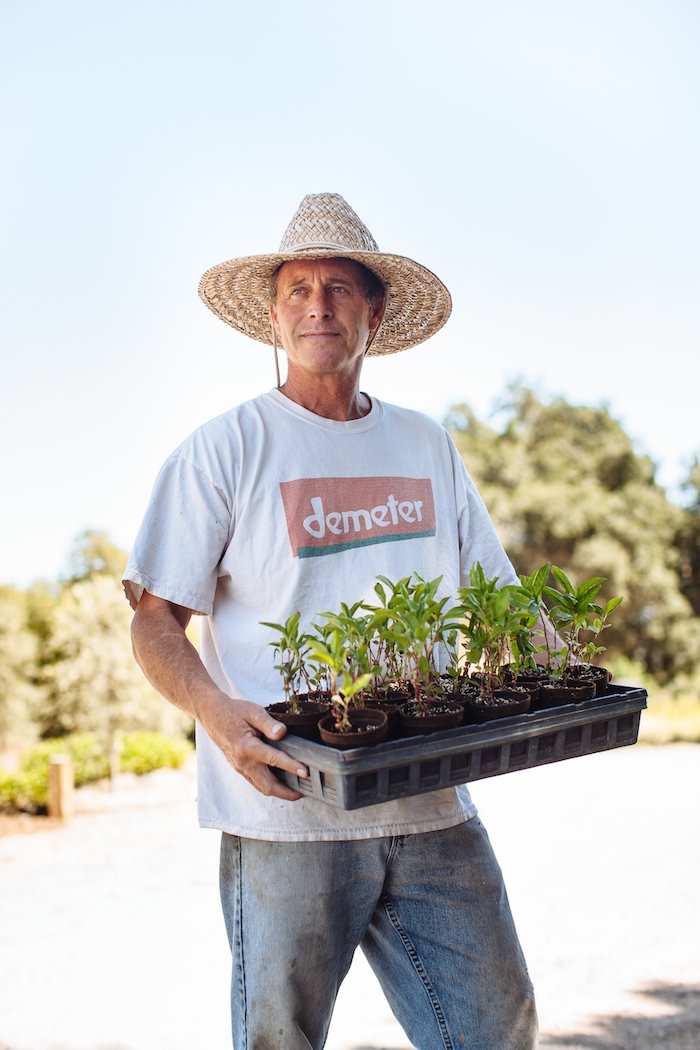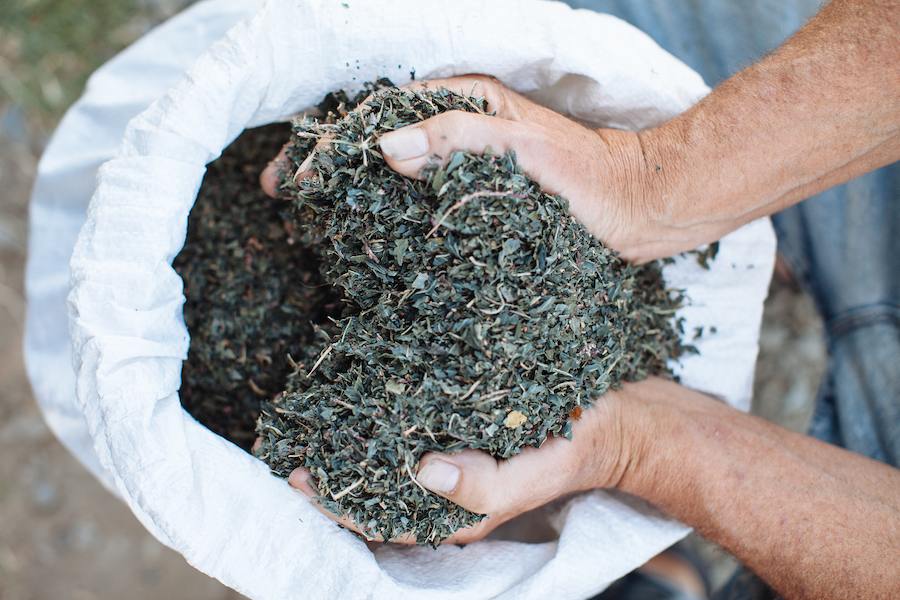Indigo crop colors hopes for local soil-to-skin clothing.
On a balmy June morning off Westside Road in Healdsburg, I get my first look at the bright green pointy-leafed shrub that’s creating a stir in the northern California Fibershed community. Polygonum tintorium— otherwise known as Japanese indigo—grows in clumps at the entrance to the fiber and dye plant demonstration garden at DaVero Farms and Winery. The plants are cultivated according to Rudolph Steiner’s Biodynamic principles under the scrupulous stewardship of 53-year-old Craig Wilkinson.
It’s hard to believe that the pint-size perennials are the source of the deep blue pigment coveted around the world for centuries. Yet, come July, the indigo will be two feet tall and topped by long-stemmed fuchsia blooms. At that point, they’ll be harvested, processed, fermented, and ultimately transformed into a natural blue dye that rivals the Mediterranean Sea for its breathtaking cerulean beauty.
Japanese indigo grown to scale is new to Sonoma County. Along with Wilkinson’s starts in the demonstration garden, he has another 4,000 or so growing in 440-foot-long rows between the olive trees on DaVero’s Biodynamic acreage, where owners Ridgely Evers and Colleen McGlynn have granted Wilkinson access to the land for free.
These plants, along with another 2,400 at Deborah Walton’s Canvas Ranch in Petaluma, are part of Fibershed’s Indigo Project. It’s a natural progression of the nonprofit’s mission to set up the infrastructure for an international system of regenerative and sustainable regional textile communities that take full responsibility for a garment’s lifecycle, as they say, from “soil-to-skin.”
The seed for the project came after Fibershed founder Rebecca Burgess traveled to southeast Asia where she became determined to bring Japanese indigo—which is particularly suited to California’s temperate climate—back to the U.S. In 2011, Burgess became the first person to grow indigo at scale west of the Mississippi.
Still, it makes you wonder. Why go through all of the trouble to grow, process, and ferment indigo when the industrial textile system can dye clothing with unparalleled efficiency?
“After agriculture, the textile industry is the second-largest source of freshwater pollution worldwide,” says Erin Axelrod, who manages the Canvas Ranch indigo plants for Fibershed. “All that residue, along with microfibers and plastics, is going into local waterways.”
Axelrod points to what she’s wearing: jeans topped with an electric blue shirt, bought for $4 at a thrift store.”Until I can make my own indigo blue, we’re using a coal derivative to produce this color,” she says. “We’d be remiss if we didn’t address where our jeans and other dyed clothes are coming from—not just for the health of our own bodies, but especially for the health of people who are making them.”
According to a 2012 Greenpeace report, industrial textile manufacturing in China is wreaking havoc on the environment. The process requires billions of gallons of water and spews carcinogens and toxic chemicals into waterways, killing fish, destroying ecosystems, and polluting drinking water.
Natural dyes, says Axelrod, are an important part of a needed shift from an exploitative, destructive industrial clothing system to one that is local, non-toxic, and regenerative.
“Fibers and dyes are one of the most universal connectors,” she adds.
Wilkinson says that the fiber and dye garden “is just the beginning of a conversation.” There’s still a great deal of study to be done regarding the efficacy of growing indigo in Sonoma County. In fact, he’s still sorting out answers to essential questions: What are the land requirements? What are the labor costs? And, extremely important during an ongoing drought, what are the plant’s water needs?
“Last year, I gave them as much as they wanted and they do like water,” Wilkinson admits. This year, he’s trying to suss out the minimum water inputs needed for the plants to thrive.
We’d be remiss if we didn’t address where our jeans and other dyed clothes are coming from—not just for the health of our own bodies, but especially for the health of people who are making them. Erin Axelrod
Indigo may be, horror of horrors, a water-lover, but it also offers beneficial elements for soil and pollinator health. Practitioners of permaculture laud it as a nitrogen-fixer. Plus, indigo’s ability to produce a second harvest from one plant makes it appealing in a whole-systems sense. Not to mention that bees adore its pink flowers.
After years experimenting with indigo in her backyard garden, Burgess expanded to 6,000 plants at organic farms in the Capay Valley and in the west Marin town of Lagunitas. In 2014, the project arrived in Sonoma County with Axelrod’s work at Canvas Ranch and Wilkinson’s biodynamic propagation at DaVero and a former site in Penngrove. The ultimate goal is to produce 440 pounds of indigo leaves, a feat that requires about 5,000 plants. Those 5,000 plants will be harvested by hand. Wilkinson kneels down to demonstrate the harvesting process. First, he gathers the two-foot shrub into one hand. Then, using a sickle that looks straight out of the 18th century, he slices through the bottom stems before placing the leaves and stems into a large tote bag. And then moves on to the next plant. “As you can imagine, it gets pretty tiring after a while,” he says.
After being harvested by hand, the leaves are placed on a large tarp to dry in the sun. Once the plants become “crispy,” the stems get sorted out, and the remaining leaves and flowers are loaded on a truck and sent to an organic farm in Nicasio, the site of the region’s only indigo composting floor. Built in 2012 by Fibershed with the help of Japanese indigo expert and University of Indiana professor Rowland Ricketts, the composting floor uses a combination of rice hulls and other organic materials, heat from the composting process, and regular watering and turning to create sukumo, or composted indigo leaves. The sukumo is mixed with water and wood-ash lye plus hydrated lime and wheat bran and then poured into a dye vat. At this point, the magic of fermentation takes over, hopefully producing a beautiful blue dye within about a month. After all of that work, it’s time to dunk and dye fibers in the vat, which can be used over and over. It’s a painstaking, multi-stepped process fraught with potential failure.
“There are many variables leading to the actual dye,” Wilkinson acknowledges. Knowing the labor-intensive steps involved certainly gives a perspective on the higher price point for natural indigo-dyed clothing and textiles.
At the end of the line, the sukumo will be sold to small-scale craftspeople, Axelrod says. To that end, Fibershed offers consultation on how to use the leaves and the fermentation dye vat. Axelrod says that Levi Strauss & Co. actually has some of Fibershed’s sukumo, but she’s unaware if they’ve actually used it.
Last year’s indigo, all grown and processed in Marin, Sonoma, and Yolo counties, is being used for Fibershed’s “Grow Your Jeans” project. The cotton for the jeans was raised by Sally Fox, an organic cotton farmer from the Capay Valley. The fabric was woven with a human-powered loom in San Francisco. The design and sewing of the pants is being done by Dan DiSanto in Alameda. The jeans, which will cost a bit over $500—because everything in the supply chain has been accounted for—will debut in Bolinas this October.
And, unlike the toxic China-made jeans I bought at The Gap a few years back, the Fibershed denim will carry a little bit of Sonoma County in every thread.



[…] http://madelocalmagazine.com/2015/07/true-blue/ […]